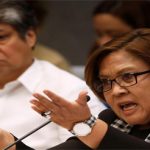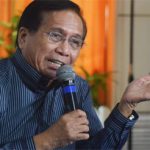Supreme Court Associate Justice Marvic Leonen asked Solicitor General Jose Calida about highlighting only a part of the late dictator Ferdinand Marcos Sr.’s life to support the government’s decision to allow his burial at the Libingan ng mga Bayani (LNMB).
“Why is it that the government wishes to take only part of the life of Marcos and highlight it to use it as a justification to bury him in the Libingan ng mga Bayani, but tones down the other portions of this individual?” Leonen asked on September 7, the second day of the oral arguments on the consolidated petitions filed to stop Marcos’ burial at the heroes’ cemetery.
Leonen brought up Republic Act 10368, An Act for Reparation and Recognition of Victims of Human Rights Violations During the Marcos Regime, Documentation of Said Violations, Appropriating Funds Therefor and for Other Purposes.
“Mister Marcos is also named in a law, RA 10368, as having provided the atmosphere for at least 75,000 human rights violations during martial law. Yet the administration now wants to take that into account and only use a portion of the life of this individual as justification to bury him at LNMB,” Leon said.
President Rodrigo Duterte maintained his stand on allowing the burial of Marcos at the Libingan in Taguig City not only because he was entitled to it as a former president but also as a former soldier and war veteran.
Calida used this same position as the reason behind qualifying Marcos for a hero’s burial.
“From the vantage point of the government, from the vantage point of President Duterte, it is the fact that Marcos was a former president, and also a military veteran and a soldier, your honor,” the Solicitor General said.
[ads1]
But Leonen pushed another point.
“When we bury somebody, it has to be the whole person… It’s the entire person viewed from what he is in history, what he is to the relatives, what he is to friends,” he said.
“Which part of President Marcos is president and which part of the person is being accused by the human rights victims?” he added.
The government acknowledges the sufferings of the victims during Martial Law, but Duterte’s decision did not take this part into consideration, Calida said.
“Your honor, every matter was taken into consideration. My point here is, it is a question of policy and wisdom of President Duterte,” he said, adding that Duterte merely wanted to pursue a policy of “national reconciliation and healing.”
Calida also said that the efforts to provide reparation to the human rights victims are ongoing.
Duterte earlier said that he believed there was no more Marcos trauma among the Filipinos, based on the number of people who voted for former Senator Bongbong Marcos, the dictator’s son.
The petitioners insisted that giving Marcos a hero’s burial will be an injustice to his victims, “who continue to cry out for justice.”
On the first day of the oral arguments with the human rights victims, Associate Justice Antonio Carpio said that Marcos was “dishonorably” discharged as the president and Commander-in-Chief through the People Power Revolution in 1986, hence he did not deserve to be buried at the heroes’ cemetery.
Sources: (gov.ph, gmanetwork.com)
[ads3]


